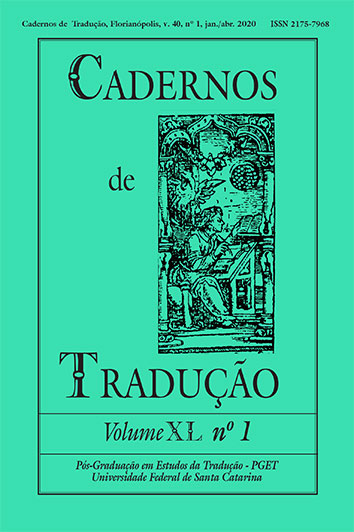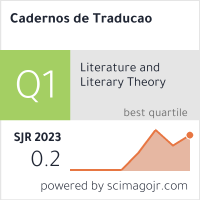Shakespeare visita o mundo virtual: o uso de Emojis em reescritas de suas peças
DOI:
https://doi.org/10.5007/2175-7968.2020v40n1p34Resumo
Este estudo faz uma análise da série OMG Shakespeare, cujo objetivo é levar para o público jovem, através do uso da linguagem digital, as peças de William Shakespeare. A série apresenta reescritas das peças de Shakespeare no formato de mensagens de WhatsApp. Os quatro títulos disponíveis são: srsly Hamlet, Macbeth #killingit, YOLO Juliet and A Midsummer Night #nofilter. Busca-se determinar: i) o conceito geral da série; ii) as principais estratégias empregadas na adaptação intermidiática das peças e iii) as relações entre as linguagens verbal e não verbal nos textos. O arcabouço teórico desta análise baseia-se nos conceitos de intermidialidade de Irina Rajewisky (2010) e Werner Wolf (1999), na teoria dos signos de Charles Peirce (1998), nas concepções de modalidade e de mídia de Lars Elleström (2010, 2013) e nos conceitos de adaptação de Linda Hutcheon (2013).
Referências
Alshenqeeti, Hamza. “Are Emojis Creating a New or Old Visual Language for New Generations? A Socio-semiotic Study”. Advances in Language and Literary Studies. 7.6 (2016): 56-69. Australian International Academic Center. 10/02/2019. http://www.journals.aiac.org.au/index.php/alls/article/view/2823
Bloom, Harold. The Western Canon: The Books and School of the Ages. 1st ed. New York/San Diego/ London: Harcourt Brace & Company, 1994.
Boston, Michelle. “Six reasons Shakespeare remains relevant 400 years after his death”. USC News, February 10, 2016. Web. 8/06/2019 https://news.usc.edu/91717/six-reasons-shakespeare-remains-relevant-400-years-after-his-death/
Elleström, Lars. “Iconicity as meaning miming meaning and meaning miming form.” Signergy. 9. edited by C. Conradie et al. Amsterdam/Philadelphia: John Benjamins Publishing Company, 2010: 73 – 100.
Elleström, Lars. “The Modalities of Media: A Model for Understanding Intermedial Relations.” Media Borders, Multimodality and Intermediality. Hampshire/New York: Palgrave Macmillan, 2010: 11-50.
Elleström, Lars. “Spatiotemporal aspects of iconicity.” Iconic Investigations, edited by Lars Elleström, Olga Fischer and Christina Ljungberg. Amsterdam/Philadelphia: John Benjamins Publishing Company, 2013: 95-117.
Elleström, Lars. “Adaptation and Intermediality.” The Oxford Handbook of Adaptation Studies, edited by Thomas Leitch. New York: Oxford University Press, 2017: 509-526.
Elleström, Lars. “Identifying, Construing, and Bridging over Media Borders.” Scripta Uniandrade. 16:3 (2018): 15-30. Web. 10/02/2019. https://uniandrade.br/revistauniandrade/index.php/ScriptaUniandrade/article/view/1162/926
“Emoji.” Merriam-Webster.com, Merriam-Webster, 2019. Web. 13/02/2019. www.merriam-webster.com/dictionary/emoji
Garber, Marjorie. Shakespeare and modern culture. New York/Toronto: Pantheon Books, 2008: xiii-xxxv.
Hateley, Erica. Shakespeare in Children’s literature: gender and capital culture. New York/Abingdon: Routledge, 2009.
Hutcheon, Linda with O’Flynn, Siobhan. A theory of adaptation. 2nd ed. London and New York: Routledge, 2013.
Matei-Chesnoiu, Monica. “Space, Place, and Shifting Worlds in Shakespeare and Cervantes”. Acta Iassyensia comparationes, special issue: 400 years with Shakespeare & Cervantes. Universitatea Alexandru Ion Cuza, 2017. Web. 10/02/2019. literaturacomparata.ro/aic/?page_id=677&lang=fr
Oittinen, Riitta. “Audiences and influences: multisensory translations of picturebooks.” Whose Story? Translating the Verbal and the Visual in Literature for Young Readers, edited by Maria Gonzáles Davies and Riitta Oittinen. New Castle: Cambridge Scholars Publishing, 2008: 3-18.
“OMG Shakespeare!” RHTeachersLibrarians.com, Random House Children’s Books, 2015. Web. 10/02/2019. https://images.randomhouse.com/promo_image/9780553535396_3456.pdf
Peirce, Charles Sanders. The Essential Peirce: Selected Philosophical Writings, v.2. Edited by the Peirce Edition Project. Bloomington/ Indianapolis: Indiana University Press, 1998..
Rajewisky, Irina O. “Border Talks: The Problematic Status of Media Borders in the Current Debate about Intermediality.” Media Borders, Multimodality and Intermediality, edited by Lars Elleström. Hampshire/New York: Palgrave Macmillan, 2010: 51-68.
Rippl, Gabriele. “Introduction”. Handbook of intermediality: literature – image – sound – music, edited by Gabriele Rippl. Germany: De Gruyter, 2015: 1-31.
Shakespeare, William; Carbone, Courtney. Macbeth #killingit. New York: Penguin Random House, 2016.
Shakespeare, William; Carbone, Courtney. srsly Hamlet. New York: Penguin Random House, 2015. Impresso
Shakespeare, William; Wright, Brett. A midsummer night #nofilter. New York: Penguin Random House, 2016.
Shakespeare, William; Wright YOLO Juliet. New York: Penguin Random House, 2015.
Shuy, Roger W. “Four Misconceptions about Clarity and Simplicity.” Language Arts. 58.5 (1981): p. 557–561. Web. 10/02/2019 www.jstor.org/stable/41961366
Wolf, Werner. The Musicalization of Fiction: A Study in the Theory and History of Intermediality. Amsterdam/Atlanta: Rodopi, 1999.
“Word of the year 2015.” OED Online, Oxford University Press, 2015. Web. 14/02/2019 en.oxforddictionaries.com/word-of-the-year/word-of-the-year-2015
Downloads
Publicado
Como Citar
Edição
Seção
Licença
Autores mantêm os direitos autorais e concedem à revista o direito de primeira publicação, com o trabalho simultaneamente licenciado sob a Licença Creative Commons Atribuição 4.0 Internacional (CC BY) que permite o compartilhamento do trabalho com reconhecimento da autoria e publicação inicial nesta revista.
Autores têm autorização para assumir contratos adicionais separadamente, para distribuição não exclusiva da versão do trabalho publicada nesta revista (ex.: publicar em repositório institucional ou como capítulo de livro, com reconhecimento de autoria e publicação inicial nesta revista).










































